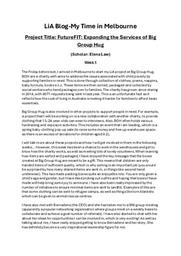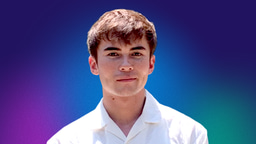Scholar Spotlight - Thomas Zaugg

Discover more Scholar Spotlights.
Thomas Zaugg, a Laidlaw Scholar at EPFL, delves into controlling perception to investigate crowding
Research Title:
Vase or Face? Controlling Perception to Investigate Crowding
Do you see a vase or faces? I have asked that question hundreds of times during my research project. Both answers are correct - just never at the same moment - and it is this bistability the Rubin vase is known for.
With the help of this illusion, my research aimed to studying visual crowding, a phenomenon where objects are rendered unrecognizable in clutter. First, I showed that perception can be steered on demand. A slight change in background color reliably pushes observers toward either the vase or the two faces while every contour of the image stays identical. With this tool, I tried to probe visual crowding through placing a crowding task into the illusion. The question was whether crowding strength depends on which object (vase vs faces) the viewer believes they are looking at. But there was a problem: once participants juggled the extra Vernier task, the illusion collapsed and they no longer held a stable interpretation. That setback is most likely related to the central bottleneck of attention.
This work matters because pinpointing where crowding peaks can shape safer cockpit, automotive and medical displays, and the same insight could drive adaptive overlays that ease crowding in macular degeneration or dyslexia. More fundamentally, holding the image constant while perception flips pinpoints the moment sensation becomes conscious, giving computational and neural models a clean benchmark.
In short, a century-old illusion is helping us map - and ultimately shrink - the blind spots created by visual clutter.
Where did your passion for this research originate?
Vision is my primary gateway to the world - you’re too using it right now to read these lines. However, it misleads us more often than we realize. Illusions, hallucinations, blind spots, and ambiguous figures like Rubin’s vase all reveal how fluid perception really is. Probing those moments fascinates me and feeds a larger obsession with the brain. I am deeply interested in understanding it from its outward signatures - behavior and neural activity - to the inward, private texture of conscious experience. We remain a long way from a complete explanation, but contributing even a small step toward that goal is what drives my research.

What is the most memorable moment from your Laidlaw scholarship experience so far?
Definitely the Laidlaw Scholars Conference. Those four days in Leeds were a whirlwind of workshops and poster sessions, but the true highlight was the people. In that brief window, I met scholars from every continent, each stretching my perspective with their research stories and life paths. Connections formed quickly and have kept growing: in the photo you can see Maria Ramadan—whom I met at the conference—and me skiing together in the French Alps six months later. I’m deeply grateful to have met such remarkable individuals. Ultimately, this vibrant community is Laidlaw’s greatest gift.

What is the biggest challenge you came across in your research and leadership journeys so far, and what did you learn from it?
My greatest challenge has been confronting the world’s true complexity. In school and university, we spend years absorbing knowledge that someone has already secured; even the hardest exam problems come with a known solution. Research offers no such safety net: the questions are open-ended, and nothing guarantees an answer is waiting. More than once my project ran straight into that blank space. Those moments forced me to accept that uncertainty is the norm and that progress often means navigating ambiguity rather than conquering it. Learning to embrace complexity, in science and in life, has become the hardest - and most valuable - lesson of my Laidlaw journey.
What does it mean for you to be a Laidlaw Scholar?
Being a Laidlaw Scholar means belonging to a community of ambitious and outstanding individuals. The Foundation generously provides a wealth of opportunities—funding for research and service projects, leadership education, and a global network of resources. Because we each arrive with different backgrounds and goals, every scholar takes something unique from these offerings. Yet one thing unites us all: the question of how we can use what we gain to make the world a better place. For me, being a Laidlaw Scholar means connecting with this community and together fight for this common concern.

Which particular leaders inspire you the most and why?
Simone Weil inspires me above anyone else. She treated attention as the highest form of generosity: to look at reality - people, problems, even pain - without turning away is, for her, an ethical act. That idea threads directly through my work on visual perception. When I study how task changes make an illusion disappear, I am reminded that the way we attend quite literally creates the world. Weil pushes me to ask not just what the brain sees, but for whom that knowledge will matter. Her life also models humility; she never separated thinking from serving, volunteering in refugee camps while also writing brilliant essays. She shows that rigorous inquiry and human concern are not competing goals - they are the same discipline viewed from different angles of the same, ever-shifting illusion.
Briefly describe a scene from the future you are striving to create.
Many of today’s challenges are planetary in scale, yet the mindset to solve them begins close to home. I aim to help build a world grounded in understanding: of the physical world we live in, the ecosystems that sustain us, the people who share them, and the workings of our own minds. While I pursue global answers through research and collaboration, I want to create a local community guided by shared respect, curiosity, and humor. At every level - planetary or local - empathy remains my guide.
Quick-fire Questions
📺 Favourite Film:


Beethoven 9. Sinfonie in d-Moll op. 125

🌈 Something that made me feel joy recently:
Swimming in the Lake Geneva with friends.

If you want to learn more about Thomas's work, explore his research here and follow him on LinkedIn. Thomas is a Laidlaw Undergraduate Leadership and Research Scholar at @EPFL. Become a Laidlaw Scholar to conduct a research project of your choice, develop your leadership skills, and join a global community of changemakers from world-leading universities.
Find out more about the Laidlaw Scholars Undergraduate Leadership and Research Programme.
🔦 Discover more Scholar Spotlights:
⚡️ Anuj (AJ) Manchanda, a Laidlaw Scholar at the University of Toronto, delves into how Environmental CSR initiatives shape consumer choices.
⚡️ Sebastian Glasper, a Laidlaw Scholar at the University of Leeds, explores social media’s role in mitigating loneliness among older adults.
⚡️ Sophia Waseem Khan, a Laidlaw Scholar at Durham University, champions sustainable agriculture through innovative ion recovery.






Please sign in
If you are a registered user on Laidlaw Scholars Network, please sign in